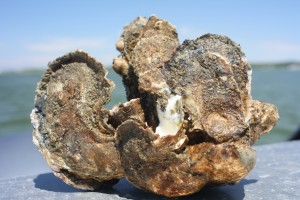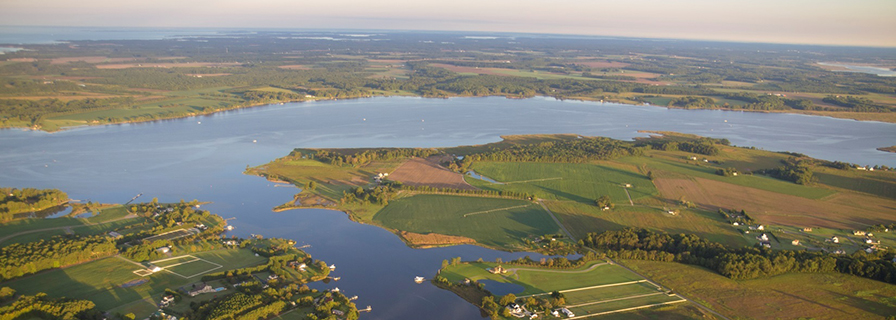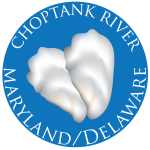Choptank River Complex, Maryland/Delaware
The Choptank River complex is located on Maryland’s Eastern Shore and includes the Choptank River and its major tributaries. This treasured part of the Chesapeake Bay ecosystem represents critical habitat for spawning striped bass and river herring, as well as historically abundant oyster reefs. Residents of the watershed—including many families who have lived there for multiple generations—have traditionally been employed in agriculture or commercial fishing. Recreational fishing, hunting, and boating attract millions of people each year and contribute significantly to the region’s economy.
NOAA’s interest in the Choptank is driven by significant public and private investment in native oyster restoration in three of the Choptank’s major tributaries: the Little Choptank River, the Tred Avon River, and Harris Creek. The population of Eastern oysters (Crassostrea virginica) in the Chesapeake Bay has declined dramatically over the past century due to overfishing, habitat loss (including poor water quality), and disease. Plus, oysters grow in reefs that provide needed habitat for a range of Bay species, filter water as they feed, and are a valued and historical fishery.
Unprecedented, large-scale efforts are necessary to recover the population and benefits. The Chesapeake Bay Watershed Agreement, signed by Chesapeake Bay Program partners in 2014, set restoring oysters in 10 Bay tributaries by 2025 as a major goal. Work in the Choptank Habitat Focus Area will accomplish restoration of three tributaries toward this goal.
Threats
Given continued population growth and land development, there is an ongoing change in human settlement patterns and cultural identity of the Bay’s Eastern Shore. This change is leading to many challenges:
- sustaining traditional working waterfronts
- protecting and restoring natural shorelines
- preventing marsh loss and migration
- reducing vulnerability to coastal inundation and increased storm surge
- reducing nutrient runoff to improve water quality
- preventing waterfowl and aquatic habitat loss
- maintaining an agricultural land base
As such, several key habitat types in the region have decreased over time:

- Bottom Habitat: In 2010, approximately 69% of the Choptank’s bottom habitats were degraded.
- Native oysters: Populations have declined dramatically over the past century; current populations are estimated to be less than one percent of historic levels.
- Wetlands: Acreage represents about a 56% reduction over historic levels with much of the documented loss attributed to conversion of non-tidal wetlands.
- Submerged Aquatic Vegetation: Distribution has been highly variable but trending downward in the past decade, likely due to influences of water clarity and temperature.
Objectives
The ultimate objective is a healthy Choptank River ecosystem. To that end, NOAA and partners have identified three near-term objectives:
- Habitat restoration and protection: Restore and protect habitat, including oyster reefs, wetlands, and opportunities for dam removal for fish passage.
- Integrating science to inform management: Establish a baseline condition for the Choptank ecosystem and related uses as a basis for detecting and quantifying changes over time. Explore and understand the cause-and-effect relationships that drive these changes.
- Community engagement: Engage local communities through Envision the Choptank to increase involvement in and ownership of the protection and restoration of coastal habitats
Collaboration
NOAA’s efforts leverage partnerships with other agencies, public and private organizations, research and science institutions, and local communities. NOAA works with partners including:
- U.S. Army Corps of Engineers’ Baltimore District, Maryland Department of Natural Resources, The Nature Conservancy, the Oyster Recovery Partnership, and the University of Maryland Center for Environmental Science on oyster restoration.
- The Chesapeake Bay Program’s network of partners to achieve goals associated with the Chesapeake Bay Watershed Agreement related to fisheries, habitat, and environmental education
- Local conservation organizations to implement habitat restoration and community engagement activities: e.g., Eastern Shore Land Conservancy, Chesapeake Conservancy, The Chesapeake Bay Foundation, The Nature Conservancy, Midshore Riverkeeper, Town Creek Foundation, Sultana Education Foundation,Pickering Creek Audubon Center, Maryland Sea Grant Extension
Accomplishments
- Restored nearly 830 acres of oyster reef in the Little Choptank River, Tred Avon River, and Harris Creek.
- Developed a climate vulnerability assessment that combines social, structural, and natural resource vulnerability with anticipated effects from a changing climate to determine places in the Choptank watershed that most need climate adaptation.
- Established a partnership initiative, Envision the Choptank, and developed the Choptank Common Agenda to guide its work.


